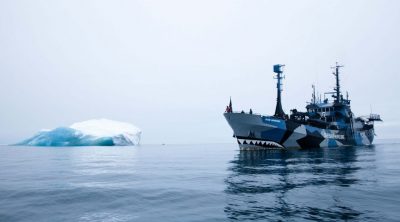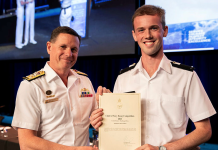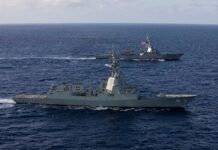 Affirmative: Neptune’s Navy: A Navy by any Other Name
Affirmative: Neptune’s Navy: A Navy by any Other Name
By Chris Rawley and Claude Berube
A rarely asked but fundamental question is: how do we define a navy? The answer might appear to be self-evident. Merriam-Webster defines a navy as: the part of a country’s military forces that fights at sea; a group of ships; a nation’s ships of war and logistic support; and the complete naval establishment of a nation including yards, stations, ships, and personnel.
Featured image: SSCS’s Bob Barker alongside an iceberg. (Jim Watters / Sea Shepherd Australia Ltd)
But are these criteria accurate or sufficient in the twentieth century? The authors assert that under a more appropriate definition, the maritime arm of the Sea Shepherd Conservation Society (SSCS) is a navy. How does Sea Shepherd meet those criteria?
“…a group of ships…” Certainly Sea Shepherd meets this first criteria. It operates a fleet of ships that include former U.S. Coast Guard cutters, a former weather survey ship, a former fisheries protection ship, and others. But a “group of ships” could also allude to a commercial shipping fleet or even a cruise line.
“…yards, stations, ships and personnel…” Sea Shepherd has paid staff as well as thousands of volunteers operating globally.
“…forces that fight at sea…” Although its ships have operated for forty years, the organization gained notoriety with its operations in the Southern Ocean, chronicled on cable television’s “Whale Wars.” Sea Shepherd ships searched for, located, pursued, and challenged Japanese whaling ships. Elsewhere, Sea Shepherd has worked with countries and even Interpol. During Operation Thunder, SSCS vessels chased an illegal fishing trawler 10,000 nautical miles, until the ship was scuttled off the west coast of Africa and the violators were brought to justice.
A Post-Westphalian Model
Taken collectively, the above three criteria suggest that Sea Shepherd has a navy, but perhaps the most important traditional component of the above definitions is that a navy must be an arm of a nation. State recognition may not be a necessary criteria in the 21st century. For example, Israel and Taiwan both maintain navies. But 31 United Nations member states do not recognize Israel as a nation, and only 21 UN member states recognized the Republic of China (Taiwan.) Does this mean Taiwan’s 116 ships do not constitute a navy to countries that do not recognize it? Does this mean Israel’s eleven corvettes and missile boats, five submarines and forty-five patrol boats do not constitute a navy in the eyes of countries that do not recognize it?
Indeed, the United States’ own history suggests that one need not be a recognized national entity to maintain a navy. No country immediately recognized the legitimacy of the thirteen colonies. Though there was a Continental sea-shepherd-logoNavy, the Continental Congress as well as states authorized letters of marque to privateers and several states created their own navies. At first, the navy relied on converted merchant ships until warships could be built from the keel up. The same has been true for Sea Shepherd which had – until this summer – relied on purchasing former commercial or governmental ships. This has changed with the M/Y OCEAN WARRIOR, their first purpose-built ship built from the keel up at Damen Shipyard.
Legitimacy
The fundamental issue of a national navy in the twenty-first century may not exclusively be a nation of borders which often contains conflicting political views, but might also include an international organization of like-minded individuals who seek policy changes that are effectively executed through its maritime branch. What is more important than borders, the traditional definition of a nation, is that an organization have legitimacy. Sea Shepherd is a non-profit organization with offices in numerous countries and authorization to operate out of a number of foreign ports, such as those in Australia. Sea Shepherd derives its legitimacy from the countries that support or condone it. It has now operated with several countries (Ecuador, Sao Tome and Principe, Gabon and others) to serve as a maritime law enforcement agency. And, as noted earlier, it has worked with Interpol on at least one major operation. SSCS has also been subject to litigation for their actions, but so have more traditional navies and their representatives. To fund the OCEAN WARRIOR, Sea Shepherd received money through the Dutch Postcode Lottery, after competing with other organizations.
neptunesnavy
Several of Sea Shepherd’s ships. (Sea Shepherd photo)
Sea Shepherd isn’t alone in this new breed of non-state Navies. The Migrant Offshore Aid Station, or MOAS, stood up in 2014 to rescue migrants in the Mediterranean Sea. Since then, the organization’s professional and volunteer crews, along with their two ocean going vessels, Schiebel S-100 camcopters drones, and small boats have rescued more than 24,000 people in the central Mediterranean and Aegean seas. Earthrace Conservation, founded by former Sea Shepherd member Pete Bethune and staffed by former special operators, has also conducted wildlife protection missions in conjunction with a number of foreign militaries and maritime law enforcement agencies. Earthrace is currently crowd-funding the construction of a new sea-going fast patrol trimaran.
More than a Fleet in Being
One of the distinguishing characteristics of navies from coast guards is that navies perform missions in support of global interests. Many navies do not or rarely conduct blue water operations and have more regional interests – or simply do not have the political will or financial ability to operate globally. Ships are certainly the core of a navy, but without the funding, logistical support, and perhaps most importantly, trained professionals, they are dead in the water. Sea Shepherd refers to their missions as “direct action,” which is not analogous to combat, as their objective is to protect wildlife rather than pursue violent clashes with other naval forces. However, SSCS tactics – which include disrupting other vessels and boardings (sometimes with host nation military riders embarked) – are analogous to maritime security and presence missions common to many navies in peacetime.
Sea Shepherd operates its ships in the Southern Ocean, the Pacific, the Mediterranean, and the Atlantic. Sea Shepherd has an order of battle – an ocean going fleet – of at least eight vessels. Its volunteer crews often make several multi-month voyages, giving them more at-sea experience than many navies whose sailors may make one or two deployments before returning to civilian life. Only the largest of the world’s navies routinely operate aircraft off their ships. SSCS’ small naval aviation arm consists of a variety of unmanned air systems and helicopters and is vital for over-the-horizon scouting during open ocean pursuit missions.
Conclusion
While the definition of a navy may be debated, the fact that Sea Shepherd has a fleet that conducts global operations to promote or enforce policies and has gained legitimacy from nations suggests that it qualifies as a navy. Moreover, as Sea Shepherd and other like-minded organizations continue to expand and professionalize, the likelihood that they will engage – either positively or negatively – with traditional nation-state navies will increase.
Negative: Sea Shepherd’s Fleet is not a Navy
By Ryan Mewett*
The trawler Thunder, sinking in seemingly calm waters after being pursued by the SSCS. (AFP/Getty)
The Sea Shepherd Conservation Society is an organized, committed activist group and a noteworthy non-state actor with coherent political objectives and worldwide reach. It operates a fleet of nine vessels with varying operational capabilities on missions around the globe. Best known for its depiction in the reality television series Whale Wars, SSCS conducts operations ranging from cooperation with coast guards and constabulary navies in fisheries enforcement to harassment and attempted interdiction of whaling vessels. Last year, two SSCS vessels pursued a trawler with a history of illegal fishing for over three months, covering more than 10,000 nautical miles of ocean before the trawler sank, likely scuttled by its crew. During the chase, the SSCS crews demanded the suspect vessel stop fishing, threatened law enforcement action, and ultimately prevented it from fishing by cutting its nets. The recently launched MV Ocean Warrior, the organization’s first purpose-built vessel, is reportedly capable of speeds of up to 30 knots, may support helicopter operations, and is scheduled for its first anti-whaling operation to begin later this month. For all this, Sea Shepherd’s fleet is not a navy.
It is deceptively difficult to define just what exactly a navy is, though any definition is bound to be descriptive in nature. Is a navy defined by its mission? In the most general sense, we might say that navies pursue political ends through the use of force at sea – but the same is true of maritime terrorists. Is a navy defined by a set of attributes? We might say a navy is a fleet of ships that is organized, centrally and hierarchically controlled, with a clear mission, that takes purposeful action to achieve its objectives. Alas, for any set of attributes, we can cite examples that are clearly not navies (in this case, say, Carnival Cruise Line or Maersk Lines, each of which check all of these boxes). Even prominent naval theorists are silent on the point: neither Mahan nor Corbett offers a definition, though Mahan tellingly notes in The Influence of Seapower Upon History, 1660-1783 that “[t]he necessity of a navy … springs therefore from the existence of peaceful shipping, and disappears with it…,” seemingly suggests that a navy’s fundamental role is ensuring the safe conduct of commercial traffic on the sea. The naval historian N.A.M. Rodger posits a definition based on common usage: “The common sense of the word [navy] as we use it today refers in this context to a permanent fighting service made up of ships designed for war, manned by professionals and supported by an administrative and technical infrastructure.”
I propose that each of these attempts at definition contain necessary attributes of a navy, but only Rodger’s includes the crucial point: a navy fights. Any plausible definition of a navy will include a variety of descriptions on the nature of the organization and its objectives, but I challenge the reader to define it in a way that both includes organizations that obviously are navies and excludes organizations that clearly are not without reference to this fundamental – and the burden of a positive definition must lay with those who would class Sea Shepherd’s fleet as a navy.
We can find a productive comparison with the example of organized violent actors on land. Clearly, there is a wide range of organized groups that use force to achieve their objectives: armies, police forces, terrorists, gangs, and some criminal enterprises, to name a few. Armies, police, and terrorists all pursue political objectives. What then separates armies from police and terrorists? It is not enough to say that they act on behalf of a state, because we can think of groups we would have no trouble referring to as “armies” who are non-state actors, including insurgent groups like the Viet Cong or guerrilla armies like Hezbollah’s. There is, however, a fundamental capability difference between armies on the one hand, and other groups like police or terrorists on the other. The non-army groups are limited in their ability to use force; they are capable of using violence for political ends against unorganized or unarmed opposition, but cannot stand and fight against an equivalent group. (As this capability approaches the margins of the scale, the group becomes more like an army; a SWAT team is more a unit of a paramilitary army than a police squad, and terrorists who attack hard targets are more accurately guerrillas.)
In the same vein, a seagoing organization– in addition to being organized, having hierarchical command and control, pursuing political objectives, as well as perhaps having other characteristics not discussed – must have the capability to fight to be truly classed as a navy. That fighting capability is what permits the navy to exercise the core function from which other roles stem: to exert some level of sea control, on a scale from outright command to simple denial, in pursuit of political objectives against a competitive, capable opponent. An actor whose ultimate recourse is to another legitimate authority that truly will use force cannot credibly be said to exercise sea control. The Tamil Tigers had a navy. The Sea Shepherd Conservation Society does not.
*Claude Berube teaches at the United States Naval Academy. He has published three non-fiction books and two novels. Follow him on Twitter @cgberube.
* Captain Chris Rawley is a surface warfare officer and entrepreneur. Follow him on Twitter @navaldrones.
* Ryan Mewett is an active duty submarine officer in the United States Navy. Follow him on Twitter @REMewett.
The opinions and assertions contained herein are the private opinions of the authors and are not to be construed as official or reflecting the views of the Department of Defense, the United States Government, the U.S. Naval Academy, or the United States Navy.
Republished with permission of the Center for International Maritime Security.



